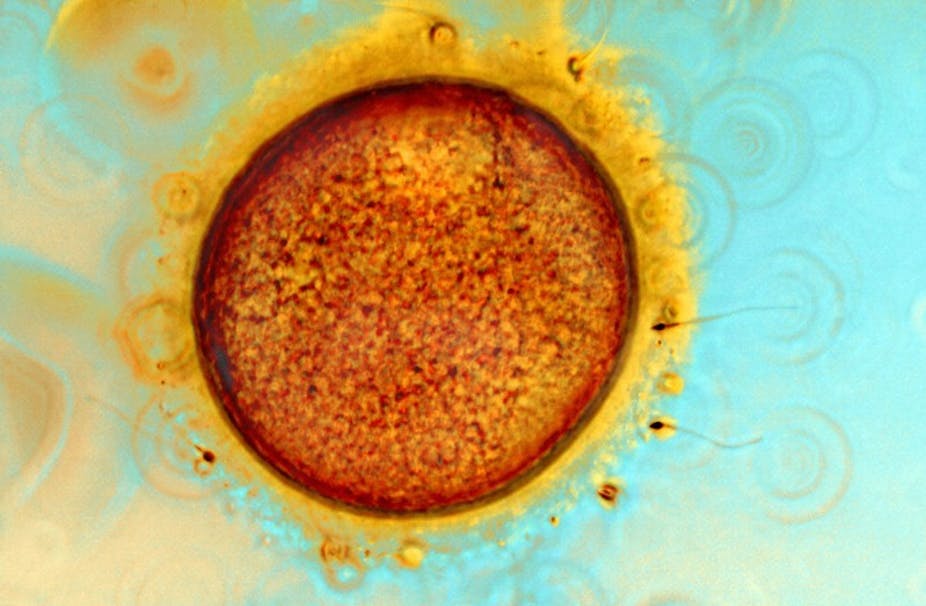On the face of it, a sperm’s work seems pretty straightforward: locate an egg and fertilise it. Job done.
But in the world of a sessile broadcast-spawning marine invertebrate – immobile organisms in which both sexes emit their gametes (reproductive cells) into a turbulent marine environment – the business of finding that egg becomes a lot more complicated.
Add to this the fact not all eggs encountered by a sperm will come from the same species (think of corals that spawn en masse on a single night) and suddenly the odds of successful fertilisation seem very remote indeed.
Nature’s solution
Thankfully, nature has offered a neat solution to this problem. Eggs emit chemical cues, called chemoattractants, that function as chemical signposts directing sperm towards the source of these chemicals (the egg).
This was the starting point for research done by my colleagues and me, published recently in Proceedings of the Royal Society London B.

Chemoattractants causes a change in the chemical composition of the sperm’s tail (a rapid influx of calcium ions), which alters the movement pattern of the sperm by changing the beating behaviour of its tail. The result is that the sperm alters its orientation towards the source of the chemoattractant in a process known as sperm chemotaxis.
This sort of chemical communication between eggs and sperm turns out to be ubiquitous among sexually reproducing organisms, including many internally fertilising species such as humans.
Getting the message
So eggs communicate with sperm, but what information are they conveying in these messages? Until now, chemoattractants were thought to contain two basic pieces of information:
First, there is the “here I am” message, which is achieved because chemoattractants enable sperm to locate their target from a distance.
Second, there is the “who I am” message, made possible because chemoattractants often carry specific chemical signatures which are unique to a particular species.
Both properties of sperm chemoattractants are neatly demonstrated by research on gastropod molluscs, showing that sperm are able to follow species-specific chemical cues that guide them towards eggs from conspecific (same species) females.
But is this the end of the story? What other information might be conveyed in these chemical signals?
A sexually selected role for egg chemoattractants?
Along with my colleagues at the Centre for Evolutionary Biology at the University of Western Australia, I have been interested in addressing a simple question: are egg chemoattractants involved in mate selection, and thus do they serve the additional function of directing sperm towards eggs from certain females over others?
We ask this question because there are obvious reproductive benefits of picking the “best” partner. For instance, it’s pretty useful to avoid mating with one’s own siblings.
We reasoned that in the world of a sessile marine invertebrate, in which both sexes shed gametes into the water, such “choices” must be left to the sperm and eggs themselves.
Indeed, we know that sperm and eggs do make such “choices” via the proteins expressed on their outer membranes (so-called “gamete recognition proteins”).
Wouldn’t it be useful, therefore, if a mechanism enabled sperm to orient towards the “correct” egg before they actually make contact? Our recent work on mussels points to such a mechanism.
‘Mate choice’ in blue mussels?
Our paper focuses on the common blue mussel (Mytilus galloprovincialis) and asks whether egg chemoattractants have the potential to direct sperm towards eggs with which they are most compatible.

Mussels are broadcast-spawning marine invertebrates which are anchored to rocks, pier pilings or any other suitable substrate for much of their lives. As with other sessile organisms, mate choice prior to gamete release is not an option.
We performed two experiments designed to test whether sperm differentiate among eggs from different females according to the chemical signals these eggs emit.
In the first, we sought to establish patterns of gamete compatibility using simple in-vitro fertilisation techniques. In this experiment, each trial involved mixing an ejaculate from a single male with eggs from a single female in a Petri dish.
We used a factorial design in these trials and found that certain male-female crosses exhibited higher fertilisation rates than others, and that these patterns depended on the specific combination of males and females used in each trial.
For instance, Male One might do better with Female A than with Female B, but Male Two would exhibit the opposite pattern (i.e. do better with B than with A). Such male-by-female interactions at fertilisation are common in many species, so in this respect our work supports other studies showing certain mating combinations are more compatible than others.
But our second experiment provided us with a surprising new insight into sperm behaviour. In this experiment we set up a series of “choice” trials, whereby sperm were added to the centre of a divided chamber and eggs from each of two females were placed at either end of the chamber.

In order to make a choice of egg, sperm cells would have to follow their “noses”. Importantly, we used the same individual males and females in these trials as in the previous Petri dish experiment.
We found the direction in which sperm swam in each trial closely matched the fertilisation patterns observed in the previous experiment. Thus, to use the same hypothetical scenario envisaged above, sperm from Male One would preferentially swim towards the chemoattractants emitted from Female A’s eggs, while Male Two’s sperm would exhibit the opposite pattern.
Thus, sperm make choices – consistently favouring certain female chemoattractants over others – and these choices appear to direct them towards the eggs with which they are most compatible.
Challenges for the future
As is often the case when we discover something unexpected, we end up with more questions than we started with. Among the most pressing is the need to understand the mechanisms that underlie a sperm’s choice of eggs.
We know from recent work on sperm chemotaxis that sperm are able to fine-tune their chemotactic responses according to variation in the chemical environment they encounter.
Our research suggests these fine-tuned responses must also take account of the subtle characteristics of an egg’s chemical “signpost”.
It would seem that a sperm’s job of finding that egg is far more complicated than we’ve been led to believe.

